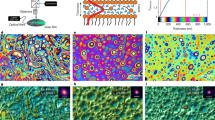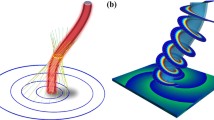Abstract
In this paper, a quasiparticle concept was proposed to understand the branched flow of light phenomenon. Combined with the geometrical optical theory, we successfully established a model to simulate the branched flow of light with this novel perspective. Our model owns an intuitive physics picture, without losing generality. Moreover, we demonstrated that a special structure with the fixed position and specific refractive value of quasiparticles can be designed, a controllable branched flow pattern of light will be correspondingly attained for future experimental guidance.




Similar content being viewed by others
References
M.A. Topinka, B.J. LeRoy, R.M. Westervelt, S.E.J. Shaw, R. Fleischmann, E.J. Heller, K.D. Maranowski, A.C. Gossard, Coherent branched flow in a two-dimensional electron gas. Nature 410, 183–186 (2001)
M.P. Jura, M.A. Topinka, L. Urban, A. Yazdani, H. Shtrikman, L.N. Pfeiffer, K.W. West, D. Goldhaber-Gordon, Unexpected features of branched flow through high-mobility two-dimensional electron gases. Nat. Phys. 3, 841–845 (2007)
D. Maryenko, J.J. Metzger, F. Ospald, V. Umansky, R. Fleischmann, T. Geisel, K. von Klitzing, J.H. Smet, How branching can change the conductance of ballistic semiconductor devices. Phys. Rev. B 85, 195329 (2012)
B. Liu, E.J. Heller, Stability of branched flow from a quantum point contact. Phys. Rev. Lett. 111, 236804 (2013)
R. Höhmann, U. Kuhl, H.-J. Stöckmann, L. Kaplan, E.J. Heller, Freak waves in the linear regime: a microwave study. Phys. Rev. Lett. 104, 093901 (2010)
S. Barkhofen, J.J. Metzger, R. Fleischmann, U. Kuhl, H.-J. Stöckmann, Experimental observation of a fundamental length scale of waves in random media. Phys. Rev. Lett. 111, 183902 (2013)
M.A. Wolfson, S. Tomsovic, On the stability of long-range sound propagation through a structured ocean. J. Acoust. Soc. Am. 109, 2693–2703 (2001)
L.H. Ying, Z. Zhuang, E.J. Heller, L. Kaplan, Linear and nonlinear rogue wave statistics in the presence of random currents. Nonlinearity 24, R67 (2011)
O. Emile, J. Emile, Soap films as 1D waveguides. Nanofluid 1, 27 (2014)
A. Patsyk, U. Sivan, M. Segev, M.A. Bandres, Observation of branched flow of light. Nature 60, 583 (2020)
Patsyk, A., Bandres, M. A.; Segev, M. Interaction of light with thin liquid membranes. In Conference on Lasers and Electro-Optics FF3E2 (Optical Society of America, 2018); https://www.osapublishing.org/abstract.cfm?uri=CLEO_QELS-2019-FTu3D.1.
T. Schwartz, G. Bartal, S. Fishman, M. Segev, Transport and Anderson localization in disordered two-dimensional photonic lattices. Nature 446, 52–55 (2007)
H. Trompeter, W. Krolikowski, D.N. Neshev, A.S. Desyatnikov, A.A. Sukhorukov, Y.S. Kivshar, T. Pertsch, U. Peschel, F. Lederer, Bloch oscillations and zener tunneling in two-dimensional photonic lattices. Phys. Rev. Lett. 96, 053903 (2006)
H.B. Perets, Y. Lahini, F. Pozzi, M. Sorel, R. Morandotti, Y. Silberberg, Realization of quantum walks with negligible decoherence in waveguide lattices. Phys. Rev. Lett. 100, 170506 (2008)
S. Longhi, M. Marangoni, M. Lobino, R. Ramponi, P. Laporta, E. Cianci, V. Foglietti, Observation of dynamic localization in periodically curved waveguide arrays. Phys. Rev. Lett. 96, 243901 (2006)
Y. Plotnik, O. Peleg, F. Dreisow, M. Heinrich, S. Nolte, A. Szameit, M. Segev, Experimental observation of optical bound states in the continuum. Phys. Rev. Lett. 107, 183901 (2011)
This concept is different with electron quasiparticle in solid state physics.
The copy of figure permission will be authorized by Springer Nature.
P.P. Mondal, A. Diaspro, “Ray Optics, Wave Optics and Imaging System Design” in Fundamentals of Fluorescence Microscopy (Springer, 2014).
Acknowledgement
This work was supported by the National Natural Science Foundation of China (Grant Nos. 12004424 and 11847012). We thank Prof. Sidong Lei from Georgia State University and Prof. Wei Zhang in our department for fruitful discussions.
Author information
Authors and Affiliations
Corresponding author
Ethics declarations
Conflict of interest
The authors declare no competing financial interest.
Additional information
Publisher's Note
Springer Nature remains neutral with regard to jurisdictional claims in published maps and institutional affiliations.
Rights and permissions
About this article
Cite this article
Huang, C. A new model for explanation and generation of branched flow of light. Appl. Phys. B 127, 58 (2021). https://doi.org/10.1007/s00340-021-07608-7
Received:
Accepted:
Published:
DOI: https://doi.org/10.1007/s00340-021-07608-7




